Vicia faba
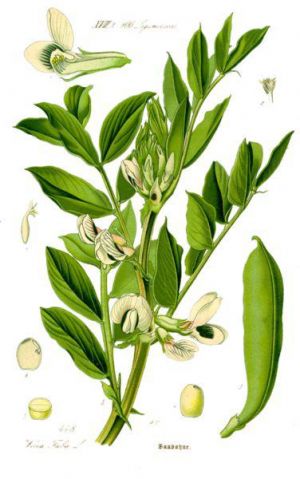
Broad beans are fairly easy to grow, sown in early or late winter at the beginning or end of winter, depending on the region. This is a vegetable that can be eaten very fresh. fresh.
Preparing the soil
Even if exports are limited, fava beans have high nitrogen significant nitrogen requirements, so a supply of organic matter organic matter, not too fresh, is required. It may therefore be advisable to apply the amendment in autumn of the previous season the previous season and then cover it for the winter, if the crop is not sown at that time of year.
The crop is grown on tarpaulin or organic mulch,
the straw is brought into the greenhouses by hand to a thickness of
10 to 30 cm thick. Be careful when planting
at the start of the season, because in the event of frost, the straw prevents the warmth of the soil from protecting the plants.
the heat from the soil to protect the plants.
spread later in the season.
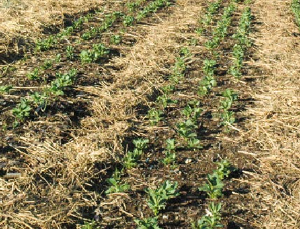
Planting
Two types of planting are possible :
- Sowing in place, in rows or in bunches in November, with the disadvantage of providing rodents with food for the winter. The spacing required for sowing is as follows : in rows, every 10-15 cm on rows 50 cm apart, or in bunches of 3 beans, every 25 cm.
- Nursery sowing : 3 beans per pot or in trays with 1 bean per tray ; the seedlings will be transplanted during the second half of January. This avoids the problem of seedlings disappearing and ensures uniform emergence. In the case of planting, a tarpaulin can be installed to limit grass cover. The planting density will then be 16 to 19 plants/m².
However, the density will depend on vegetative development, which development, which depends on the richness of the soil.
Crop monitoring
In rich soil, the fava bean plant can grow to a height of almost 2 metres high, so staking is essential. Various systems are possible :
- Horizontal trellising : multi-tiered cages made of concrete mesh or sheep netting, placed around the plant in the first few weeks. Staking is then carried out 2 to 4 times throughout the crop (every 30 to 40 cm) to prevent stem breakage during fruit formation.
- Thick wires surround the crop and are attached to deep posts.
The crop is relatively long, so mulching or tarpaulin is necessary to limit undesirable growth.
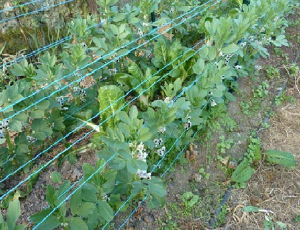
Tip
If the expected vegetative production is do not underestimate the importance of staking. Plants may break.
Irrigation
Irrigation is not necessarily systematic, but to ensure that ensure the crop's water requirements, especially in the greenhouse, plan to install a drip system at the base of the plant or asprinkler system especially from flowering onwards. Be careful too much sprinkling can lead to early senescence. premature senescence.
Harvesting
Harvesting is carried out by hand, either green or dry, with the pods ripening from the bottom to the top of the plant. ripen from the bottom to the top of the plant. Ripeness is measured by by the firmness of the beans and the colour and texture of the pods. The crop is harvested in several batches.
Variety
D'aguadulce : Good production, slightly shorter but earlier.
Storage
Beans do not keep well for long, and are best sold fresh. is preferred. However, they can be stored in a cool place for afew days at a temperature of between 6 and 8°C and a humidity around 95%.
Pests and diseases
The main pests are aphids : these can be controlled by can be controlled by the presence of crop auxiliaries such as ladybirds and lacewings. If aphid pressure is too high, topping beyond the 5th/6th stage of the bean of beans can limit the problem. This will encourage pod development development of the pods while eliminating a stock of aphids. of aphids. It is also possible to spot treat with a black soap-based solution.
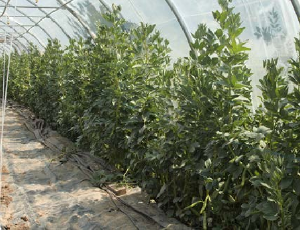
Adapting to the soil and climate
In regions with mild winters, beans can be planted as early as the beans can be planted as early as November. This makes it possible earlier than usual. However, be careful to protect plants during frosts, especially if the flowers have already have already emerged. In regions with harsh winters, it is preferable to prefer to plant the crop later, from mid-January, so that the flowers so that the flowers come out after the last frosts.
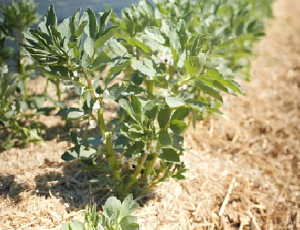
Possible ITK variations
It is possible to sow under straw with three rows over 80 cm or grow peas on a trellis in the middle.
Photo gallery
Sources
- This page is based on the guide Introduction au maraîchage sol vivant from MSV Normandie.
